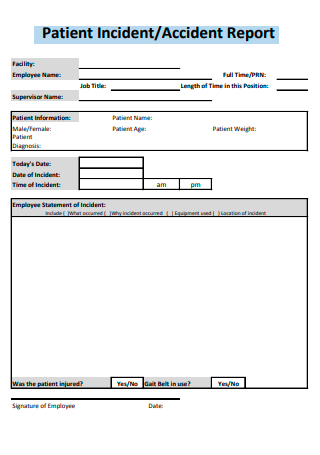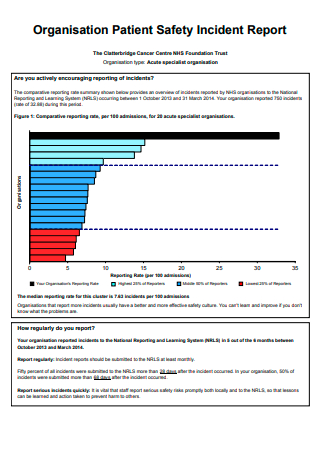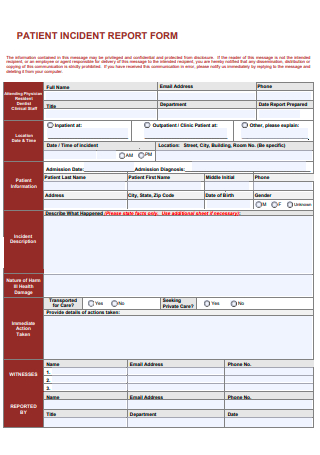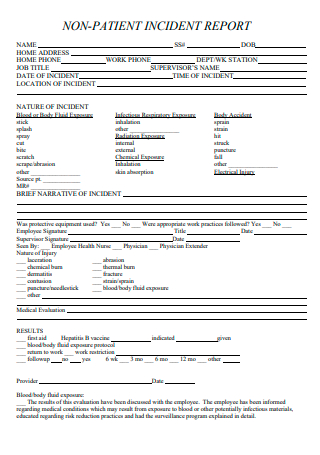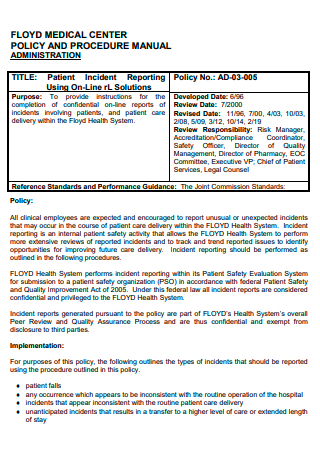5+ Sample Patient Incident Report
FREE Patient Incident Report s to Download
5+ Sample Patient Incident Report
What Is Patient Incident Report?
What Is the Purpose of the Patient Incident Report?
What to Include in a Patient Incident Report?
What Are the Benefits of Patient Safety Reporting?
Types of Incident Report
How to Create an Efficient Patient Incident Report
FAQs
How Effective Are Incident-Reporting Systems for Improving Patient Safety?
When to Report an Incident to the Police?
How Are Patient Safety Event Reporting Systems used?
When it comes to the quantity and nature of injuries incurred by patients as a result of medical treatment, incident reports can provide a wealth of information. This is true if they have been thoroughly reviewed and if a cautious attitude has been adopted when assessing the findings. Using incident reporting systems for learning is essential for achieving long-term risk reduction and patient safety improvements that are sustainable, and even more, work must be done to accomplish these goals. It has been accomplished, but it has not been simple or quick. And it’s certainly not on the magnitude that some other high-risk companies have previously achieved in the past. We will be able to demonstrate to our patients and their families that we can rely on what we have learned in order to provide them with consistent care that is both safe and certain if we employ the most up-to-date information available.
What Is Patient Incident Report?
Incidents are potentially dangerous incidents that have the potential to put patients or staff members at risk. Medical events are anything that can happen in the healthcare industry and can be caused by anything from equipment failure to injuries to poor patient care. Medical events can occur for a variety of reasons. Simply put, the medical system views each incident to be something that poses a threat to the health of patients or medical staff members in some way. “Incident Reporting in Healthcare,” as described in the realm of healthcare, is defined as the process of obtaining incident data and accurately presenting it for action. A newly discovered problem is recognized in order to aid in the identification and correction of the mistakes that occur. A Preliminary incident report can be filed by a designated staff member (someone who has been granted permission to file reports) or by an employee who has witnessed the incident firsthand. The majority of the time, a nurse or other staff member will file a report within 24 to 48 hours of the incident occurring. It is preferable to capture and document an occurrence as soon as it occurs in order to achieve the best possible outcome.
As defined by Berxi, a patient incident report is “a detailed, written description of the chain of events leading up to and following an unforeseen scenario in a healthcare context,” which can be either computerized or paper-based. Nurses or other qualified professionals are often responsible for completing reports. Afterward, they should be filed by the healthcare professional who was present when the incident occurred, or by the first member of staff who was made aware of it. Patient incident reports should be completed within 24 to 48 hours after the occurrence of the incident. You may even want to file the report before the conclusion of your shift to ensure that you recall all of the critical details of the occurrence. Additionally, there are associated samples of incident reports. Hospital Patient Incident Report, medical patient incident report, safety incident report, patient fall incident report, injury incident report, medication incident report, critical incident report, dental incident report, nursing incident report, laboratory incident report these reports are filed with the purpose of preventing future accidents or incidents that may disrupt the quality care given to patients and clients.
What Is the Purpose of the Patient Incident Report?
Patient incident reports provide information to facility officials about what happened to the patient. The information provided in the reports provides light on the steps that must be performed in order to deliver excellent patient care while also maintaining the smooth operation of your facility. These reports provide assistance to administrators in the following areas:
1. Management of Risks
Having the knowledge that an incident has happened can motivate administrators to address the issues that contributed to the problem’s development. As a result, the likelihood of similar situations occurring in the future is reduced.
2. Control of the Product’s Quality
Medical facilities strive to deliver the highest level of care and customer service to their patients. Examining incident reports highlights areas where improvements could be made.
3. Training
New employees can be better prepared for real-life events that may arise in the institution if they are trained using resolved patient incident reports. In a similar vein, current employees can analyze historical incident reports to learn from their own or others’ mistakes and prevent further events from happening.
4. Evidence in a Court of Law
If a patient decides to file a legal claim as a result of their incident, a complete incident record is the most critical aspect of any defensive strategy. As a result, all reports must be submitted on time, in full, and with accuracy.
What to Include in a Patient Incident Report?
A patient incident report should include the bare minimum of information regarding the occurrence, such as who was involved, what happened, where it happened, when it happened, and how it happened. You should also include ideas on how to deal with the problem in order to lessen the likelihood of further instances occurring. Every institution has its own set of requirements, however, the following elements should be included in your incident report form:
- The incident’s date, time, and place are all documented.
- The name and address of the facility where the incident happened, as well as the names of the patient and any other individuals who were harmed.
- Witnesses’ names and positions are listed.
- The nature and specifics of the incident are reported in a chronological fashion.
- Injury and/or damage details, as well as the total cost of the damage
- Name of the physician who was alerted
- Recommendations for corrective measures
First and foremost, make sure to include as much information as possible in your patient incident reports. The more information you can provide regarding what happened and how it happened, the greater your chances are of preventing similar events in the future.
What Are the Benefits of Patient Safety Reporting?
Setting the relevant key performance indicators in your organization gets easier as a result of healthcare data analysis and analysis. You can receive the following significant advantages from filing a complaint:
1. Preventive Measures Should be Taken
An incident report’s most significant feature is its ability to streamline past and current data, allowing for the detection of future issues well in advance of their occurrence. Predictive analytics can help healthcare institutions enhance the quality of patient care while also reducing the number of workplace accidents. Around 60% of healthcare executives have stated that implementing predictive analytics has increased their organization’s overall efficiency significantly.
2. Disease Surveillance and Prevention
One component of the first predictive analytics is the tracking of disease progression. The event reports provide healthcare organizations with the ability to monitor potential disease outbreaks by utilizing historical and current information. In the course of COVID-19, many hospitals have fought to keep illness outbreaks from spreading on their grounds. However, firms that had valuable data at their disposal may have had an easier time dealing with the pandemic outbreak.
3. Cost-cutting Measures
It is also possible to improve the efficiency of healthcare operations by using reporting tools. Hospitals can keep themselves out of legal issues by acquiring and evaluating incident data on a daily basis. A comprehensive medical error study analyzed the medical systems of 17 countries in Southeast Asia and investigated how inadequate reporting raises the cost burden on healthcare institutions and providers.
4. Patient Safety Has Been Improved
The ultimate purpose of incident reporting is to improve the safety of the patient. By promoting higher safety standards and decreasing medical errors, incident reporting helps you create a more stable environment for your patients to flourish in. When your hospital provides high-quality patient care over time, it will eventually develop a positive reputation.
Types of Incident Report
Even if an occurrence appears to be insignificant or has not resulted in any harm, it is still crucial to record it. Whether a patient has an allergic response to a drug or a visitor slips over an electrical cord, these occurrences provide valuable insight into how your facility can create a better, more secure environment for its visitors. Generally speaking, patient occurrences can be divided into three categories.
How to Create an Efficient Patient Incident Report
One thorough incident report should address all of the fundamental questions — who, what, where, when, and how — and provide full answers. The majority of hospitals adhere to a predetermined reporting format that is tailored to their own organizational requirements. An incident report, on the other hand, must include the following information:
1. Maintain Your Objectivity
Maintain an objective tone during the interview in order to capture the most accurate version of the incident. Do not make any conclusions or assign blame; simply record the facts as they occur. Include direct quotes from the patient and/or any persons who have been involved, if at all possible.
2. Write in a Clear and Concise Manner
In general, the better the level of writing skill you possess, the more valuable your patient incident report will be. For example, employing precise and simple language will make the inquiry process more efficient and less time-consuming overall. Additionally, appropriate grammar, spelling, and punctuation should be used. Grammar errors can distort the interpretation of details contained within the report, making it more difficult to conduct an investigation into the incident.
3. Case Management Software Should be Utilized
When you have hundreds of patients at your hospital at any given time, managing patient incident investigations can be demanding. Case management software, on the other hand, streamlines the process, allowing you to increase the overall quality of service at your business. Select a platform that is web-based in order to provide timely reporting. Because you may file your report at the scene of a patient occurrence, you’ll never miss any vital details about the incident. A platform that includes HIPAA-compliant forms makes your process more efficient and productive, ensuring that patient incidents are dealt with in a timely and appropriate manner.
In the healthcare industry, an incident is a negative event that occurs. However, the character of the incident can differ depending on a variety of situational conditions. When an occurrence results in a person’s harm or property damage, it is necessary to file an incident report. Unfortunately, for every medical error that is recorded, there are about 100 other errors that go undetected. There are a variety of reasons why medical accidents go unreported, but one of the most common is a lack of knowledge on when to file a report.
FAQs
How Effective Are Incident-Reporting Systems for Improving Patient Safety?
It is possible to acquire information on patient safety occurrences through the use of incident-reporting systems (IRSs). Even if they come with a significant financial cost, however, little is known regarding their usefulness.
When to Report an Incident to the Police?
The general rule of thumb is that an incident report should be completed as quickly as possible after an occurrence happens. Minor injuries should be reported and treated as seriously as big injuries, and they should be treated as such. These injuries may deteriorate and progress to more serious injuries or health problems in the future.
How Are Patient Safety Event Reporting Systems used?
Hospitals are replete with patient safety event reporting systems, which serve as a cornerstone of efforts to detect patient safety incidents and quality issues. Incident reporting is usually used as a catch-all word for all-volunteer patient safety event reporting systems, which rely on persons who are directly involved in the events to provide specific information about what happened.
After taking into consideration the goal, benefits, and obstacles of incident reporting in healthcare, it is obvious that reporting is required for medical institutions to function properly. Whether your goal is to improve patient safety or prevent workplace accidents, incident reporting can be useful for a variety of reasons. However, documenting, assessing, and investigating incidents in a timely and unbiased manner is not a straightforward endeavor. For managing hundreds of problems at any given moment, you require an automatic incident reporting system.

